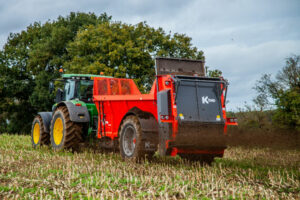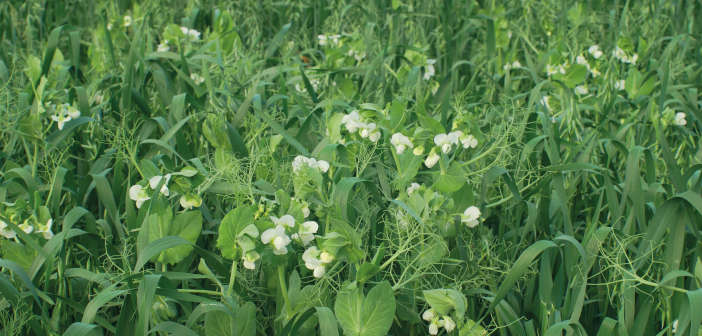A new movement is gaining pace in farming. It’s even found its way into farm policy. Yet it remains opaque, nebulous and slightly hard to define. Farm Contractor looks at Regenerative Agriculture, and what it could mean for you.
Farming is not without its fashions. Some trends come and go, only to return after a few years, when the radical alternative has proved not to be so radical after all, or the consequences demand a return to what is known to work.
Many readers will recall the arrival of minimum tillage techniques when the greatest evangelists declared that the plough had had its day. Yet the cumulative thinking of thousands of generations of farmers has shown that burying trash and crop residues by turning soil over is still a very effective way to control weeds, minimise pests and disease, and propagate new plants. The plough survives.
Most farmers recognise that the leaps forward in mechanisation, pesticide technology and fertilisers since the Second World War have increased output but at a significant environmental cost – the decline in farmland bird populations is hard to argue with. It is true that this has been led, in part, by a burgeoning and more-than-adequately fed urban consumer population, demanding cheap food. And few would deny that the industry has embraced ways of farming more sustainably.
Yet organic farming – of the signed and certified variety – has never broken out of its niche. Even when generous grant funding has been available to incentivise conversion, the area of organic land in the UK has never broken beyond the 500,000ha mark and has in fact declined over the last decade. The percentage of UK food and drink produced organically remains between 1 and 2%. And yet, those 6,500-odd farmers all believe that this approach is the right one for them, their livestock and land.
It’s often claimed that there are “organic farming methods” and “conventional farming methods”, which are acres apart and irreconcilable. Most farmers will understand this is far from true. Instead, there are just farming methods; a spectrum of tools, techniques and approaches that range from the mainstream to the unusual.
Many have rightly observed that a binary approach to organic/ conventional serves almost no-one since plenty of conventional farmers regularly use what might be considered “organic” techniques, such as effective crop rotations and the use of livestock manures.
Regenerative Agriculture certainly seems to have captured imaginations. But perhaps uniquely in farming trends, it is relatively easy to pinpoint when the ideas behind it emerged, and what the basic principles might be.
Origins
The genesis of the concept is opaque, but its first mention seems to stem from an American farmer called JJ Rodale who began, in 1940, a series of experiments in organic farming at Emmaus, Pennsylvania. This was a radical departure event then (the Dupont company were, at the time, advertising dynamite as a method of dealing with plough pans) but after the “dust-bowl” disaster of the previous decade, many were determined to explore different methods of farming. Rodale’s son Robert (Bob) took the concept further and began using the term in the early 1980s.
Rodale determined that the number one priority in “regenerative” agriculture was soil health.
Rodale’s brand of regenerative agriculture was firmly aligned to formal organic recognition and the Rodale Institute remains committed to promoting organic farming, but the idea seems to have become just as applicable outside a certified organic environment.
While never as prolific, popular, or political as the organic movement, the interest in regenerative agriculture has continued to grow, with some notable champions. Hertfordshire farmers John and Paul Cherry founded the Groundswell show in 2015, which now attracts 2000-plus attendees. Tony Reynolds, a long-term pioneer of no-till farming continues to speak and write about his experiences. And it’s here that the boundaries between no-till, conservation agriculture and regenerative agriculture begin to blur.
Defining Regnerative Agriculture

Unlike “permaculture”, biodynamic agriculture, or nature-friendly farming, Regenerative Agriculture is somewhat easier to define, and this is usually encapsulated in five key principles. Wider definitions abound; in this emerging space it is easy for others to claim that in fact, it goes further, but most practitioners generally agree that Regenerative Agriculture hinges on five core themes.
- Minimise or eradicate soil disturbance. This means no ploughing and ideally no non-inversion tillage, relying on undisturbed soil to return to a natural structure
- Maintain soil cover at all times – either with cash crops, break or cover crops, or mulches. Protect soil from the effects of wind, sun and rain.
- Living roots in the soil for as much of the year as possible, feeding the soil biology and developing soil structure
- Diverse rotations – growing the widest range of crop species possible, that allow soil resources to recover.
- Incorporate livestock into the rotation where possible
Beyond definitions
Essentially, regenerative agriculture embraces the “law of return” – what one takes from the soil one must put back. In this way, it shares roots with organic farming but more importantly, just good old fashioned farming practice. It incorporates the “golden hoof” which most farmers would understand.
The whole approach can probably be best summed up by: “feed the soil, not the plants”. Regenerative agriculture hinges on a wider understanding of soil biology and its role in plant nutrition than the direct application of primary or secondary nutrients. Feeding the great community of biological actors in the soil makes plant nutrients available for uptake, while plant root exudates are simultaneously feeding fungi and microbes. They depend on organic matter, which is both the food and catalyst for the whole system.
It’s easy to say: “regenerative agriculture is about feeding soil biodiversity”, but many people will understand different things from that sentence. In fact, soil biodiversity is the sheer variety of life below ground from very simple organisms to recognisable friends like earthworms and ants. The complex interaction of all these players below ground is what delivers nutrients in available forms to plants while collecting nutrition directly from the plants and decaying organic matter. This is a very different approach to understanding soils than simply dividing them into silty or sandy clay loams or focussing on cation exchange capacity. In fact, science has barely begun to fully understand the complexity of soil life and how it delivers “ecosystem services”. These include the ability of soils to repair themselves by breaking down and destroying pollutants.
Most definitions of soil biodiversity divide the life below ground into four groups, from the surface downwards. At the top are the bugs that most recognise as indicators of healthy soil; earthworms, ants, beetles. These can be considered the “ecosystem engineers”, opening up cavities in the soils and allowing the entry and exits of gases. The litter transformers then process organic matter, breaking it up and lowing further microbial attack. Protozoa and nematodes prey on bacteria and fungi at the base of the food web. Vast networks of mycorrhizal fungi extend through the soil, exchanging nutrients with plant roots and opening up access for them through the soil.
Long-term practitioners of no-till farming, like Tony Reynolds, have observed a darkening of soil colour, even a raising of soil level, and a reduction in the exposed stone fraction.

Why so much interest in the idea now?
Having spent so many years in the wilderness, what RA offers now (and in a sense, zero-tillage alone doesn’t do as well) is the sequestering of carbon in undisturbed soils due to extensive plant cover.
There is a widespread acceptance that soil health, in general, has declined in the second half of the twentieth century. This may be more pronounced in other parts of the world than the UK, where stable mineral clays are the norm. Nevertheless, soil losses due to wind and water erosion are common, and soil organic matter has declined measurably.
The Environmental Land Management scheme, set to be introduced from 2024, has six core elements behind it, which are linked to the government’s 25-year Environment Plan. Soil management lies at the heart of the first tier, as does the adoption of some techniques that would be recognised as part of a regenerative agriculture approach.
It may just be that this is an idea whose time has come.
Key considerations
- Soil condition at the start of the journey. It takes considerable time for soils to recover their natural structure after years of conventional cultivation; this has led to significant disappointment among farmers who have sold all their tillage kit, purchased a cross-slot drill and been rewarded with poor establishment and plummeting yields. Even the most ardent proponents of zero-tillage approaches will admit that there is a significant yield penalty in the first few years after adoption, although there is equally compelling evidence that this does correct after some time.
- Cost saving in cultivations. These are substantial but need to be offset by reinvestment in low-disturbance drills and the application of organic matter.
- Re-equipping to handle and destroy cover crops
Useful Links
Linking Environment & Farming (LEAF) www.leafuk.org
BASE UK (Biodiversity, Agriculture, Soil & Environment) www.base-uk.co.uk
Rodale Institute www.rodaleinstitute.org
The Groundswell Agriculture Show www.groundswellag.com


